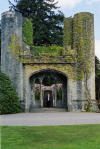|
A Stroll at Kinloch
Our walk on the grounds of Kinloch Lodge brought us to an old, moss-covered woods. We could scarcely tell whether some trees were living or dead, but we could easily imagine them having witnessed centuries of Scottish history and the Lordship of the Isles. We enjoyed our stroll, and drove the following morning to Armadale Castle, stopping a few places along the way.
Ramblin' by the Cuillins
The Cuillin Hills formed the backdrop for these photos. We admired them only from a distance, which did not truly reveal the magnificent, rugged terrain that attracts so many climbers. The Black Cuillins, composed of basalt and gabbro, present the most challenging climb in Great Britain. The Red, composed mainly of granite, have weathered into more rounded hills.
The Sound of Sleat
After his dreadful defeat at Culloden and flight to Skye in 1746, Bonnie Prince Charlie may have stood just so, grieving over his failed bid for the throne. Prince Charlie's Cave, where according to tradition he hid for a time from the English, is near here on the southwest corner of the Sleat Peninsula. From there, he escaped to the island of Raasay and sailed to France, never to return to Scottish soil.
Castle Knock
Also known as Caisteal Camus or Chamius, Castle Knock was captured by the MacDonalds and remodeled in 1596. By 1689, it was abandoned, reputedly haunted by the Green Lady or "Gruagach". According to legend, the Green Lady was a portend of the fortunes of the castle owners. A happy ghost meant good fortune, but a weeping one was an ill omen indeed. Perhaps the Green Lady wept a great deal, for the castle fell to ruin and most of its stone was removed. A few miles more, and we arrived at Armadale Castle.
Armadale and The MacDonalds
About 1790, a simple, small white mansion was erected on the east coast of Skye for Lord MacDonald of Sleat. In 1815, when it had become popular to build manor houses resembling castles, the larger, more elaborate Armadale "Castle" was built at one end of the mansion. Some remodeling was done after a fire in 1855, but in 1925, the family moved to a smaller house several miles away and abandoned Armadale to the elements.
In 1971, the Clan Donald Lands Trust purchased the 20,000-acre Armadale Estate and set about restoring part of the castle and creating the Museum of the Isles, a Study Centre, and a Visitor Centre. The castle is surrounded by a beautiful 40-acre garden, the restored remains of a formal garden that dates back two centuries. The staircase and landing, graced by a pink clematis, as well as the turreted archway in front, constitute a "folly", an artificial ruins constructed sometime in the modern era. Elsewhere on the estate, we saw a European Robin and another patch of Bluebells.
John barely caught the little red-breasted bird on film as it was taking flight. Ayrshire birdwatcher Kevin Waite later told me this interesting bit of trivia ... "Mary Poppins" was written by an English author and set in London, and the robin to which Mary sang was not America's plump, red-breasted herald of spring depicted in the movie but its smaller, European cousin. We'll understand if Brits are a bit put off by Hollywood's miscasting of the role of this feathered friend.
Bluebells abound in Scotland in the month of May, including here on the Isle of Skye where they contrasted beautifully with a small red-leafed tree. Our visit to Scotland being in May, John and I enjoyed having the grounds of Armadale to ourselves. Too soon, we left for the final leg of our journey, stopping for photos at the west end of the town of Broadford, on the Inner Sound.
The Inner Sound
The waters of the Inner Sound separate the Inner Hebridean Isles of Skye, Raasay, and South Rona from the mainland of Scotland. At Broadford, we gazed across the Sound to the mainland's Applecross Peninsula, then stood on the shore at the head of Broadford Bay. Finally, we drove back to the Skye Bridge and the mainland, where more adventure awaited. ______ ____ |
|||||
|
If you came from the Bed and Breakfasts page,
If you came from a search, click here to begin at the beginning : Home
Copyright 2018 · Loretta Lynn Layman · The House of Lynn |





















